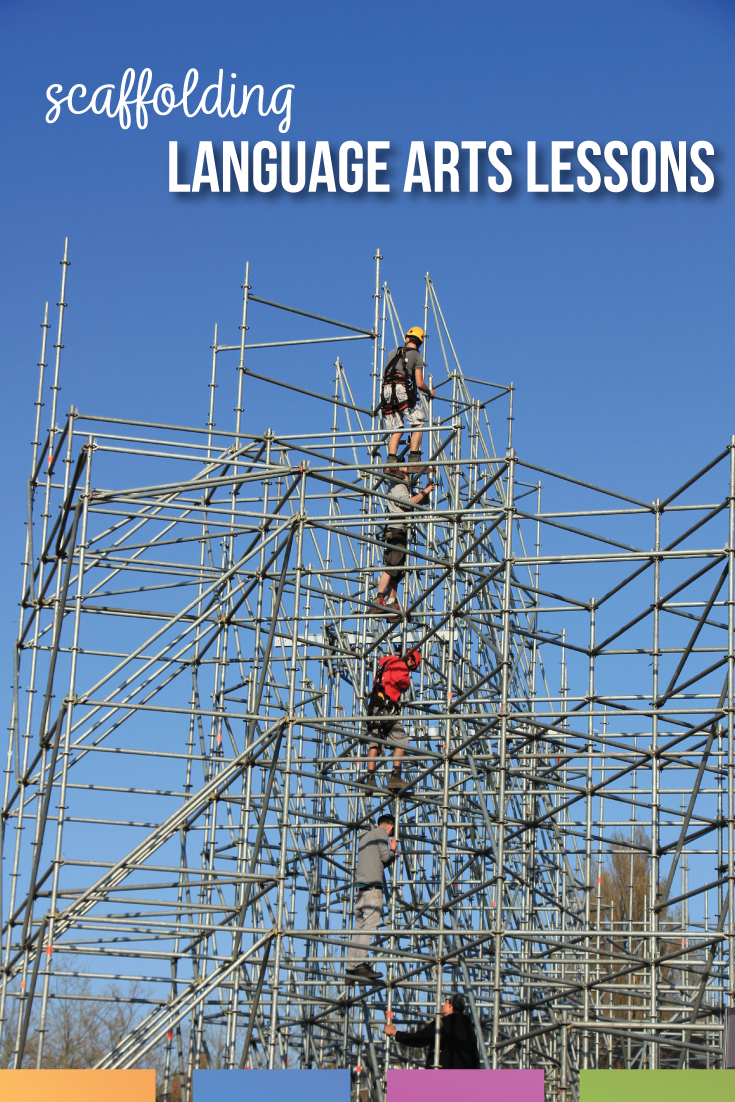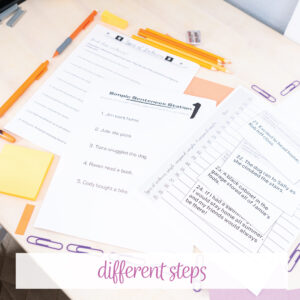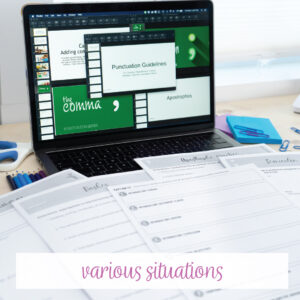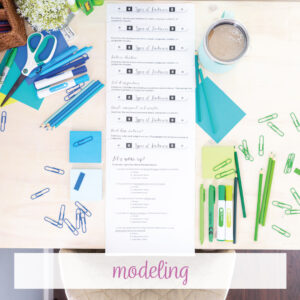Scaffold grammar lessons and provide students with meaningful instruction. Grammar and usage in the classroom can be taught successfully with purposeful scaffolding. Make ELA scaffolding a part of purposeful strategies for teaching grammar in high school .
Jumping into a grammar lesson with little framework for students will create problems. I say that from experience: I once ignored ELA scaffolding concerning language.
I’d actually say that most English teachers are scaffolding masterminds when it comes to writing, literature, and public speaking. Somehow, ELA teachers treat grammar lessons as a foreign activity and worry about switching lessons up like we do with other parts of our content. In this blog post, I outline ideas for scaffolding grammar, but overall, you’ll be able to take these ideas and apply them to ELA scaffolding as a whole.
Grammar belongs in discussions about literature, writing, and speech. It cannot be taught for a few minutes and never explicitly connected to the rest of class. Strategies for teaching grammar in high school must include a diverse approach, weaving domain-specific vocabulary throughout lessons.

Teachers can weave grammatical terminology into the rest of class, but this may not be a natural action for ELA teachers. Hopefully after reading this, you have specific ways to scaffold grammar and in the process, make grammar a natural part of an ELA class.
The more I work with students, the more I realize that strategies for teaching grammar in high school must include scaffolding. Finally, the ideas below will help with scaffolding options for language arts. Many of these grammar examples can be used for ELA scaffolding in general.
Start with prior knowledge.
With ELA scaffolding activities, start with prior knowledge. Students who speak and write English* can relate to the study of words, syntax, and mechanics. Not only does a small activity activate prior knowledge, but it also shows you what direction grammar lessons should go.
You may need to differentiate the presentation of prior knowledge. Scaffolding sentence structure might look like this:
- Give students a simple sentence without any phrases: Tom went home.
Acknowledge what students know about “Tom.” Tom. . .
- is a person, a noun.
- is what the sentence is about, the subject.
- did something (“went”) the verb.
Next, for scaffolding, add to that simple sentence: Tom went home after baseball practice and ate dinner.
Now we have another verb, joined by a conjunction. Ask students to think of the word “conjunction.” It’s like a junction— it joins. Here, it joins two verbs— “went” and “ate.” Continue scaffolding sentence structure with concepts students already know.
Add to the sentence dependent upon what concept you’re teaching. For example, you could add a dependent clause: Because he was exhausted, Tom went home after baseball practice and ate dinner.
This may seem like a waste of time, but if students put up walls before grammar lessons begin, you won’t accomplish much.
Show students what they already know, and they’ll believe they can learn more. If you still don’t have an accurate picture, give a pretest. You can see exactly where you should focus. Oftentimes, pretests surprise me. I form grammar lessons after I see the results.
That’s a fast overview of scaffolding sentence structure, but you can apply those concepts to other ELA scaffolding. Remember that strategies for teaching grammar in high school needn’t be complex: You can apply the same concepts from other ELA lessons!
Practice with different steps.
One practice that newer educational standards emphasize is to add variety in the approach of solving a problem. I think English teachers provide great scaffolding options for language arts concerning literature and writing. Grammar requires a bit of creativity, more than typical ELA scaffolding.
Grammar and usage in the classroom is more than add a comma, take away this semicolon. Present language as a choice, as a way to empower writers. Grammar can be more than a problem. Students should see many options for improving their communication.
With any scaffolding activities, I show students different ways to approach a concept.
- Look at this long sentence, that could overwhelm students: KeKe found a puppy at the park and wanted to keep it; however, her mother convinced her to take it to a shelter.
That’s long and could easily shut some students down. Too often, that happens with reading nonfiction, and students skip over difficult sentence structures. First, acknowledge that the sentence has many parts. Second, break down different ways to approach the sentence. Model and talk students through the process:
- Look at multiple pieces: This sentence has a compound verb (“found” and “wanted”); prepositional phrases (“at the park” and “to a shelter”); and infinitive phrases (“to keep it” and “to take it”).
- Next, look at all nouns (or whatever part of speech): KeKe, puppy, park, mother, shelter.
- Then, look at the subjects and verbs: KeKe found, wanted; mother convinced.
Students should develop ways to break sentences apart that has meaning for them. First, review punctuation rules. (Students should especially know the various uses of a comma.) Looking at punctuation can clue students with sentence structure, but so can conjunctions, phrases, and clauses. Demonstrate the various ways to break down sentences so students can make those processes their own.
Apply to various situations.
Later, when students are improving sentences in a speech or rearranging sentences in their writing, they will need an approach that works personally for them. At this point, recall what scaffolding techniques you have practiced with students, and ask them to apply the concept to various situations. This method often involves talking through the process with students to help them discover how to make this learning process part of their repertoire.
Eventually, students will help you think of scaffolding activities because you’ve modeled process for them. At that point, you can connect the scaffolding you’ve done with grammar lessons into other scaffolding options for language arts. Not only will you be helping students with other areas of class, but you will also be applying metacognition skills. Be sure to explain the thought process to students.
Model your thinking and approach of analyzing a sentence.
Overall, teachers model writing and reading habits for students. Scaffolding options for language arts typically include great literature discussions and modeling.
Speak your grammar analysis to your students! The above example of scaffolding sentence structure is my process. Just like scaffolding activities come naturally with other concepts, you will discover scaffolding for grammar. (I promise.)
For instance, if I gave students this sentence, I would model my approach for them: Our school’s board of education plans to eliminate the election of king and queen at prom.
I would say something like:
Looking at this sentence, I notice no commas or semicolons. That tells me that I might be finding only one subject and verb – and yep! “board of education” is the subject and “plans” is the verb. We have lots of prepositions, which means we have lots of prepositional phrases – of, of, at. I almost thought that “to” was a preposition, but then I realized that “eliminate” was a verb form and not an object of a preposition, so we have an infinitive. The verb “plans” is an action verb, not a linking verb. I could have a direct object, and yes, we do – board (subject), plans (verb) – plans what? “to eliminate.” That infinitive phrase is acting as a noun – the direct object.
Break down sentences for your students and encourage them to talk through the process, just as you would with any ELA scaffolding example. Students may not have an internal dialogue concerning grammar! Model one for them and encourage them to hear their peers’ methods. Scaffolding sentence structure can be a springboard for other discussions with grammar.
Strategies for teaching grammar in high school will include scaffolding and modeling. Sometimes, you might feel like you are taking down to students, but you probably are not. Just as you scaffold ELA content the rest of the day, you soon will be naturally scaffolding English grammar!
Step away.
Of course, at the end of scaffolding, the teacher must step away. Naturally, you will focus less on basic concepts (finding the subject and verb) and work more on the tricky parts of grammar (using words in different ways, varying sentence structure).
As you do so, acknowledge that with students. Too often, students hear “grammar” and they think “mistakes.” Grammar is a tool, a study of language which can help students in reading and writing. When you step away from scaffolding, praise students for what they have learned. Future grammar lessons will be better because of it.
Grammar needn’t be a cumbersome activity to be finished as a bell ringer and never mentioned again. Try to scaffold grammar within lesson plans, and see how students relate the concepts to the rest of ELA content.
*I have never taught ESL. My references in writing this deal with native English speakers.

If you’re interested in more scaffolding sentence structure methods or ELA scaffolding in general, join Grammar Gurus. It’s a supportive Facebook group of teachers working to make grammar meaningful.






